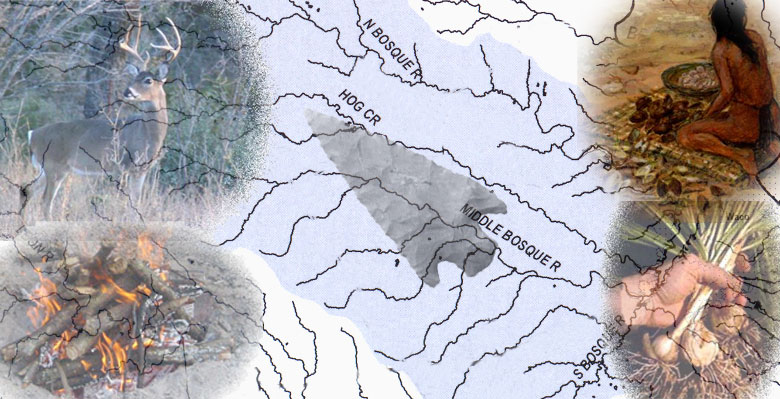|
In this exhibit we have focused on the resources and strategies used by the Bosque River people to meet the daily challenges of life during the Late Archaic period. Based on information recovered from the Britton, Higginbotham, and McMillan sites during the Waco Lake project, several subsistence patterns are evident.
The hunting and intense processing of ungulates, primarily deer, was a major endeavor at all three sites. In addition to harvesting the meat, campers crushed and cooked the bones to recover fat and marrow, as evidenced by large quantities of small fragments and spirally fractured bone. Both the McMillan and Higginbotham sites also provide evidence, in the form of burned rock middens, basin-shaped hearths, and macrobotanical remains, that an intense level of plant processing and consumption was part of the subsistence strategy as well. These foods were primarily geophytes, plants with underground bulbs, roots, and tubers. We speculate that the prime season for harvesting geophytes was in the spring. During this time, small family groups would have banded together to harvest and process the food in bulk. Evidence for lengthier periods of stay needed to accomplish these tasks is indicated by the structure and layout of these sites at certain periods, such as greater distance between features and use of refuse piles for dumping trash and maintaining activity areas.
In addition, the Bosque River people’s diet was augmented through the hunting, trapping, and collecting of smaller animals and freshwater mussels, particularly when site occupations were lengthy and acquisition of high-ranked resources such as deer likely became cost prohibitive. Mobility was key to providing access to these resources, some of which were dense enough or available at sufficiently low cost that foraging could take place in relatively small areas, supporting short movements (distances) between camps, and at times lengthy stays at camps. This nomadic lifestyle required these hunters and gatherers to possess and employ technologies that were simple and transportable, yet durable and functional.
Technological Continuity
Based on the materials recovered from the excavations, the technologies used to acquire and process these resources largely remained unchanged until the Late Prehistoric period, when arrow points replaced dart points and ceramic pottery was added. For the most part, the tool kits of the Late Archaic people consisted of bifacial chipped-stone tools, which provided durable working edges that could be resharpened and reused repeatedly and easily transported from site to site. Expedient flake tools were at times employed to accomplish simple cutting and scraping tasks. Use of these simple flakes would have conserved the working edges of the formal bifacial tools, something that was particularly important in the absence of locally available and suitable lithic materials. Intensive use of formal tools is evidenced by heavily resharpened dart points and other bifacial tools at all of the sites. The evidence suggests that many formal tools were brought to the sites as late-stage and finished specimens. Onsite knapping activities suggest tool maintenance and refurbishing occurred at all of the sites, with the primary reduction of raw materials occurring in a limited fashion only at the McMillan site.
Another critical resource for the prehistoric campers was fuelwood. Often overlooked by analysts, the types of wood used at different times provides additional insight into length of stay at the camps and, in fact, may have been a determining factor in camp location. Most of the recovered charred wood was from self-pruning trees, such as oak and pecan, indicating a good supply of fallen or dead wood was available during most of the occupations at the Bosque River camps. However, a somewhat different picture was revealed at the McMillan site. There, large amounts of charred wood from possumhaw or yaupon trees were found, indicating these small trees had been purposely cut for firewood, likely after nearby fallen limb wood had been used up or become too difficult to acquire. Further, since McMillan campers had consumed all of the easily accessible dead limb wood, their occupations may have been relatively lengthy. The absence of stone axes among recovered tools indicates that procurement of wood was confined to that which was easily obtained.
To a large extent, we believe camp locations were chosen by women, as they carried the critical role of gathering firewood and plant foods. They would have chosen a spot where useful plants were most dense, and where easily obtained firewood was prevalent. Moving a camp was hard work and, for this reason, the campers would have selected or returned to a spot with a good supply of resources, such as dense patches of geophytes, and they would have tried to acquire and use those resources as efficiently as possible. Once foods were depleted and fuelwood exhausted, campers would have had to make the decision to move to another locale or expend more energy obtaining less easily obtainable resources.
An unusual glimpse of prehistoric hunter-gatherer life is provided in remains from the Britton site. A fire roughly 1800 years ago fortuitously left the archeological "signature" of what may have been a simple wood and brush-covered structure—a series of burned soil areas and small hearth. Based on size and spatial relationship to other features, such as refuse dumps, this pattern may represent a family living area.
Overall, the picture consistently presented at the Britton, McMillan, and Higginbotham sites is one of a successful hunting and gathering way of life that remained virtually unchanged for more than 4,000 years in the North Bosque River valley. Family groups of 18 to 20 people moved from camp to camp and periodically coalesced at certain sites to process resources in bulk. As population densities increased over time, the resource base was rich enough to support hunting and gathering groups in increasingly smaller spaces.
Waco Lake and Central Texas Archeology
In a broader context, researchers have traditionally considered the Waco area as part of the central Texas archeological region, although it actually is on the periphery of this region. The archeological record and projectile point style sequences are a testament to this, as they contain elements that suggest influences and contacts with areas to the east and northeast to varying degrees over time. The Late Archaic dart points from the Britton, McMillan, and Higginbotham sites fit this pattern well. Many of the dart points may be thought of as traditional central Texas styles, such as Darl, Ensor, Castroville, Marshall, Pedernales, and Bulverde. Missing from this list of Late Archaic styles, however, are some types that are quite common to central Texas, such as Fairland, Frio, Marcos, Montell, and Williams. Some of these styles may have more local or restricted distributions throughout the central Texas region, which may explain their absence from the Waco Lake assemblages.
Dart point styles in the Waco Lake assemblages with distributions that are peripheral to or primarily east and northeast of the central Texas archeological region include Dawson, Gary, Godley, and Kent. It is interesting to note that these styles, particularly Godley which is so prevalent at the Britton and McMillan sites, are absent or nearly absent from the rockshelters in the nearby Hog Creek basin. This suggests that the groups who used these point styles, particularly Godley points, were not involved in the predominant settlement-subsistence system and therefore were outsiders, either intruders or invited guests, or maybe both, who foraged in the lower Bosque basin at certain times of the year. This leaves the groups who used Ensor, Darl, and other more traditional central Texas point styles, which are present at all site types, as the local participants in the lower Bosque basin Late Archaic settlement-subsistence system. This suggests that the Late Archaic home groups of the lower Bosque had strong economic, and possibly linguistic and kinship, ties to central Texas groups.
There are other interesting things about some of the dart points, including a previously undefined type and uncharacteristically early ages associated with Ensor points, that may have broader implications for central Texas archeology. The Untyped Group 1 dart points, so prevalent at Higginbotham, are a previously undefined type. They may be associated with a regional late Middle to early Late Archaic tradition of long, thin, triangular-bladed darts with straight stems (e.g., Bulverde, Carrollton, Yarbrough, and Provisional Type 1), with the Waco Lake examples being a later, localized variant of these earlier, more widespread styles.
Ensor points from the Britton and McMillan sites, particularly those from Analysis Unit 2 at Britton and Analysis Unit 3 at McMillan, are associated with radiocarbon dates that are at least a few hundred years older than Elton Prewitt’s Twin Sisters phase (A.D. 200 to 550), of which Ensor is a diagnostic artifact. The unusually early dates associated with the Ensor points suggest that its initial appearance in the tool kits of ancient central Texans may have been in the Waco area.
These characteristics of the dart point assemblages from Waco Lake suggest that geographically restricted variants of point types— that is, localized types—and temporal differences in the distributions of types may exist across the central Texas region. A greater scrutiny of dart point types, their variants, distributions, and temporal distributions across the region may lead to more meaningful discussions of social identity and social fields in the future, concepts that need greater attention in Texas archeology. In terms of Waco Lake, it is clear that during the Late Archaic there was a strong connection to central Texas proper, based on common dart point styles and other technologies and subsistence practices. The specifics of this connection, including the social dynamics underlying it, remain obscure, however.
If the early Historic period mirrors the prehistoric, then the Late Archaic archeological pattern across the central Texas region is not the product of a single group or monolithic culture. Archeologist and ethnohistorian Mariah Wade identified 21 native groups who lived on the Edwards Plateau alone in the mid- to late 1600s. These groups composed an enormous socioeconomic network that was maintained through alliances, dual ethnicity, ladinos (individual translators, intermediaries, or facilitators between groups), and information sharing. Various groups formed coalitions and alliances based on common socioeconomic interests, the lifespans of which likely reflected the duration or resolution of those interests (e.g., resource inequities or threats from other groups). These alliances were often cultivated and sustained through the exchange of goods and information and initiated and facilitated by individuals of dual ethnicity or mutual kinship ties and ladinos.
Although Wade presents her analysis in the context of native groups’ relationships with Europeans in the early Historic period, she clearly believes that these social mechanisms did not rise in response to the presence of Europeans. The complexity of these mechanisms indicates that they existed in prehistory as well. If such a network of common socioeconomic interests existed in prehistory—and there are no reasons to assume it did not—it would explain the regional patterns we see in the archeological record. It would explain how the Waco area was connected to the rest of the region even though multiple groups and ethnic and linguistic differences probably existed. The key to unraveling this is identifying local or geographically restricted variants of artifact types that signal social identity, not only for the Waco area but for the other regions it is connected to as well.
|
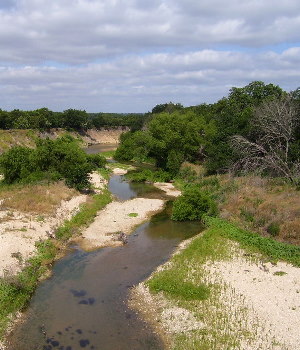
Bosque River. This view, taken of the northern section of the river, approximates how the river and its environs would have looked in prehistoric times, before Waco Lake was formed. Photo by Karl Kibler.

|
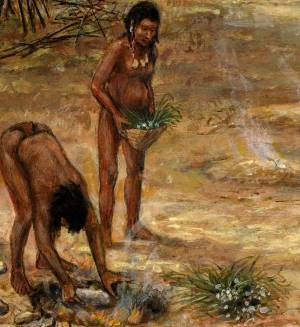
Preparing bulbs for slow roasting in a pit oven. Intensive use of geophytes (plants with bulbs or tubers) was evidenced by burned rock middens, basin-shaped hearths, and charred plant remains.

|
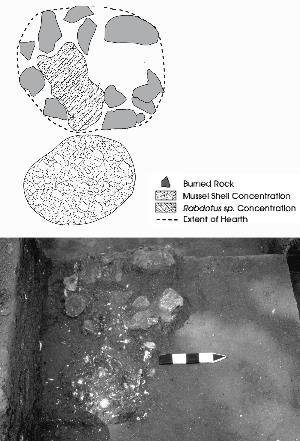
A mussel shell dump found adjacent to a small hearth was interpreted as a small family cooking area at the Higginbotham site. Several of these “paired” features were uncovered in the Waco Lake project.

|
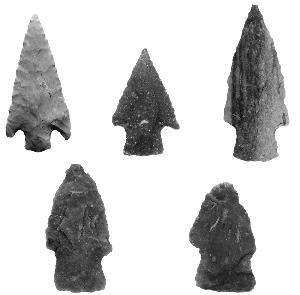
Dart points at various stages in the use-resharpening cycle. The large majority of dart points from the Waco lake sites had been resharpened or otherwise rejuvenated, to extend their use life.

|
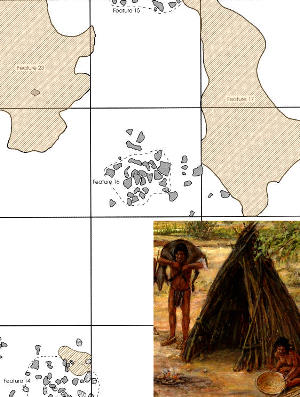
Burned soil areas at the Britton site may be evidence of a structure, such as the simple pole and brush shelter shown in the inset. Hearth features and refuse dumps on this living surface are evidence that the campers were cooking various foods and cleaning and maintaining the campsite. Such maintenance activities indicate a longer stay.

|
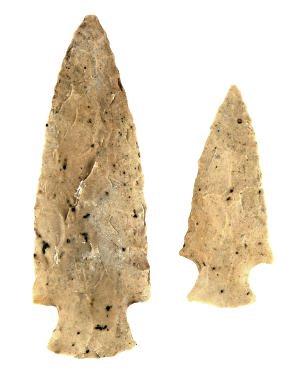
Nearly identical Godley dart points from Analysis Unit 2 at McMillan (left) and Anlaysis Unit 1 at Britton. Both are made of the same unique material and possess a strikingly similar morphology, although the Britton specimen is much smaller and has a resharpened blade.
Typically found in southeastern areas of the state, these and the many other Godley points of unknown chert found at the sites are interpreted as evidence of "intruders" in the Bosque River basin.

|
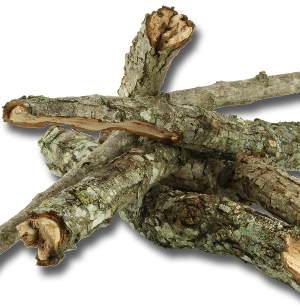
Firewood was a critical resource, necessary for cooking and warmth. Once it was depleted, groups would have had to move to another location.

|
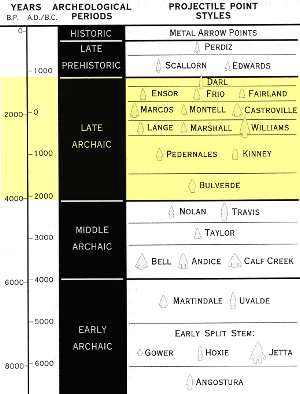
Projectile point styles typical of the Late Archaic (highlighted) and other archeological periods in central Texas.
Enlarge to see full chart.

|
|
